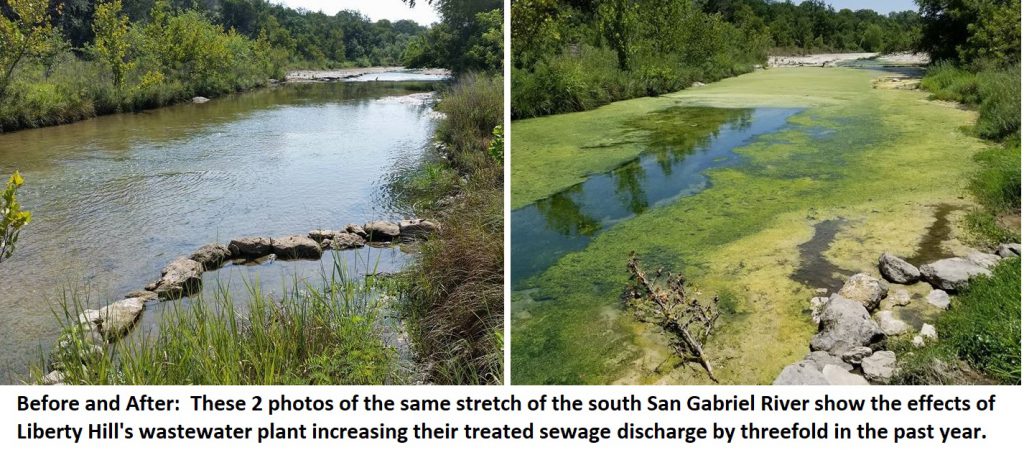Development is Generating More Sewage!
From Austin to San Antonio, population in the Hill Country is growing like never before. More development means a lot more wastewater (aka sewage) that needs to go somewhere. Unfortunately, much of this development is taking place near waterways that contribute to the Edwards Aquifer, which provides drinking water to millions of Texans and feeds our springs, creeks, and rivers.
The Most Polluting Option is “Direct Discharge”
We’re fighting to prevent the direct discharge (piped) of treated sewage into our creeks. Wastewater effluent (the product from a wastewater treatment plant) has undergone some treatment, but is not treated to drinking water standards and is not nearly clean enough to be dumped safely into our creeks and rivers. This effluent water contains high levels of nutrients (nitrogen and phosphorous) which cause algae blooms. These algae blooms are not only unsightly but through decomposition take up oxygen in the water body. The waterway may become hypoxic (lacking oxygen), causing fish and other aquatic life to perish. Algae also restricts light moving into the lower portions of the creek, altering habitat. These effects can reduce biodiversity even when a creek is not completely devoid of oxygen. At high levels, nitrogen is unsafe in drinking water, restricting transport of oxygen in the blood. This is especially dangerous for babies, children, the elderly, and young livestock. [1] Additionally, effluent water contains metals, pharmaceuticals, and many other chemicals from cleaning and body care products.[2] The full effects of these products are not yet known.
Is this Legal?
Unfortunately, bills that would have banned the practice of Direct Discharge in the contributing zone to the Edwards Aquifer died in the 2017 Texas legislative session. We continue to build grassroots support to stop this practice, in anticipation of new bills being introduced during the 2019 legislative session.
What’s so special about Hill Country creeks?
Creeks in the Hill Country are often pristine and clear. They are some of the purest water bodies in the state. These waterways have limestone beds with little soil and vegetation to absorb excess wastewater nutrients. Since these Hill Country stream ecosystems have evolved to function with very low nutrients, increased nutrients from wastewater are extremely distruptive.
These beautiful waterways also recharge aquifers (underground water bodies) that we depend on for drinking water, recreation, and agriculture. The Edwards Aquifer is extremely sensitive to pollution. This Karst Aquifer recharges quickly, which means there is little filtration of water as it moves into the aquifer from land and creeks. This same water ultimately comes up in natural springs and people’s wells.
What is the precedent for wastewater management in the Hill Country?
Currently, it is illegal by state law to directly discharge sewage into creeks in the Barton Springs Edwards Aquifer recharge zone. However, it is not illegal at the headwaters of these creeks that flow into the recharge zone (contributing zone.) Even so, to date, there have been relatively few direct discharges in the contributing zone.
New and existing permits seek to change the paradigm in favor of polluting our creeks.
Some municipalities, like Liberty Hill, first obtained a smaller permit for direct discharge, but have sequentially increased their permitted discharge to the point of fouling local waterways (the South Fork San Gabriel River). Others, such as Blanco and Dripping Springs, have applied for permits, but are evaluating other alternatives to direct discharge. At least one Hill Country development has current plans to discharge their treated sewage into Barton Creek.
Texas sewage treatment plants have been cited with numerous violations and often have harmful sewage spills
Many Texas wastewater plants have a long history of plant failure, putting further contaminants including dangerous e-coli bacteria into local waterways. For more information, please see this report of violations prepared for the Hill Country Alliance by Texas hydrologist Raymond Slade.
[1] USGS Service, https://water.usgs.gov/edu/nitrogen.html
[2]www.aquiferalliance.net/Library/GEAAPublications/GlenroseEdwardsWastewaterReport20111103.pdf

